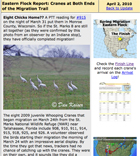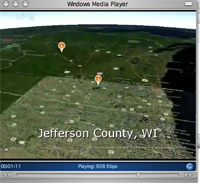Deadline April 2 at noon!
The "St. Marks 8" crane-kids completed migration April 1! Fly their journey with a quick video clip. Five 2009 DAR chicks are back too. Meanwhile, a record whooper sighting created excitement in Kansas and the time of peak Texas departures is near. Our slideshow tells how two wild cranes nicknamed YAY and RAY helped launch a new research project and one of the cranes is in this photo. What's happening?
Today's Report Includes:
- Migration News: Map and Field Reports
- Journal Topic: Migration Timing
- Research/Slideshow: RAY and YAY Are Pioneer Cranes
- Links: Helpful Resources to Explore
Image of the Week
 Western Flock News |
 Data /Map |
 Eastern Flock News and Arrival Log |
|
"We're approaching the peak departure time at Aransas," says Tom Stehn. You'll be interested in two families that left this week. A record sighting of 74 whoopers occurred April 1 on the Quivira refuge in Kansas and more are on the way! |
|
On April 1 the St. Marks 8 became the first ultralight-led cranes to complete their spring migration! The other 11 are still in Florida. Five Class of 2009 DAR (Direct Autumn Release) chicks are back, and two in Indiana. Click for more news. |
According to satellite readings from two of the birds in the group, the "St. Marks 8" made the following progress on their first journey north:
| Date | Roost Location | Miles Traveled | ||
| 3/24/10 | Shelby County, AL | 263 |
||
| 3/28/10 | Monroe County, IN | 382 |
||
| 3/29/10 | Fountain County, IN | 73 |
||
| 3/30/10 | Jefferson County, WI | 221 |
||
| 3/31/10 | Monroe County, WI | 107 |
||
Total |
? |
Dan Kaiser's photo confirmed to trackers that the st. Marks 8
were together in Indiana. |
||
- How many total miles did they fly on their journey north? What's the average number of miles they covered on each day of flying?
- What allowed these now-wild cranes to make the return migration in just one week when their ultralight-led journey south took nearly three months? Do some research with resources for this week's report before you respond in your journal. Be as specific as you can and use the words thermal currents in your answer. (See 1.5 minute video clip of the St. Marks 8's journey north.)
Tom Stehn's Answer to Last Week's Question:
Last week
biologist Tom Stehn asked why you thought cranes migrated in small
groups and left at different times. This week you can compare Tom's
answer to yours! What did you know and what did you learn?
- Teachers/Overview: About This Study
- Image of the Week: What is Happening to This Wild Whooping Crane?
- Field Report: Western Flock
- Field Report: Eastern Flock
- Lesson: Up, Up and Away:Thermals and Updrafts
- Slideshow: YAY and RAY: Two Pioneer Cranes
- Making Good Sightings: Official WCEP Reporting form
- Record Keeping: Arrival Log for Eastern Flock
- Journal: Downloadble Journey North Journal Pages

Thanks to this video clip by Heather Ray at Operation Migration, you can fly with the St. Marks 8 and complete the journey north in less than 1.5 minutes!
The Next Whooping Crane Migration Update Will Be Posted on April 9, 2010.





